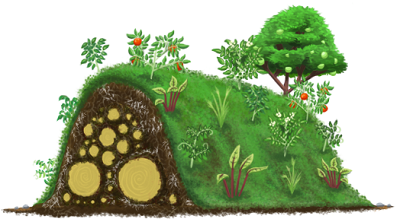The Ice Age
Ice ages occur periodically on Earth, lasting as long as 200 million years in the most ancient events, but more recent ice ages have been shorter, lasting 40-100 million years. The current ice age is only about 2.5 million years in progress, which would suggest a minimum of 37.5 million years before it would naturally end (a very long time). During an ice age, the climate cycles between glaciations, which last 40,000-100,000 years, and warmer interglacial periods which last 10,000-30,000 years (where we are today).During a major glaciation, giant ice sheets form and literally crush the continents. These sheets can be miles thick, and not only is the rock under them compressed like a soft mattress, but as the ice shifts around, rocks are lifted, moved, and crushed into smaller pieces, until only a fine dust remains. During a major glaciation, the earth looks something like this:
As you can see, Canada and the northeast US are buried under a mile of ice, as is the majority of northern Europe, southern South America (up to Brazil) and the east coast of Australia, which is usually the only part of the continent that gets any rain.
Ice ages are characterized by falling sea levels and dry weather. During the last glaciation, there was also continuous El Niño conditions as the expansive polar ice sheets disrupted oceanic currents which normally create more diverse climate conditions. Technically, the most reliable marker of an ice age is the presence of polar ice sheets, as we see over Greenland and Antarctica. During warmer phases in Earth's history, these have been ice-free most of the year and even support a considerable diversity of plant and animal life.
The 'little ice age'
In order to get a better idea of what a glaciation really means for humans, it helps to look at history, which reveals a period in which we were threatened with the onset of a full glaciation. This para-glacial period lasted from about 1300AD to about 1850AD, and is known as 'the little ice age'. Having occurred in fairly modern times, we have good records of it available, and we know that there were about three major cold spells during that time in addition to the generally cooler conditions.During this period there were several instances of 'years without summers' which occurred over most of Europe, and at least one instance where this occurred in post-colonial New York. During these years snow covered the ground all the way through July, providing no growing season for crops and leading to famines and other catastrophes. There were also times when large glaciers (but not full ice sheets) creeped across northern Europe, crushing villages and crops into dust behind them. While glaciers do not move fast enough to pose a serious or immediate hazard to humans, they would have left people plenty of time to dread the destruction of their homes and fields, completely helpless before the unstoppable and inevitable mass.
Creeping Doom
While not much is known about the cause of glaciations, scientists generally agree that when the ice sheets begin to descend from the poles it does not take them long before they cover continents. It would only take perhaps 5-20 years from onset to the disappearance of large landmasses under a sea of white.If such a thing were to occur today, the disaster that would ensue is unthinkable. All Canadians would be forced south into the US, as would people in the northeast as far south as New York and west including all the great lakes states. Smaller glaciers would tear through remaining croplands, destroying our food security further in addition to the reduction of usable space and water. Similar disasters would occur in Europe and South America, and food production would become nearly impossible in Australia. Once begun, the reflective white ice creates a runaway cooling process that we would have little hope of reversing. However, as the ice moves relatively slowly, we would have plenty of time to ponder how we will starve to death and lose our homes in the mean time.
What about Global Warming?
I mentioned before that ice ages are dry periods, but "global warming scientists" link warming with expansion of deserts. Historically, it's the warm periods of earth which have also seen the most rain, so what gives?Simply stated, the relationship is reversed. The creation and expansion of deserts has been a man-made activity for a long time, not to say that all deserts are our doing. This in turn causes a loss of soil carbon to the atmosphere and an increase in local temperature as the shade and evaporative cooling of plants is removed. We do this not by dumping CO2 into the air, as they would have you believe, but rather by tillage, fertilizer and pesticide usage. As with the dust bowls, the farmers came first, then later the deserts followed.
Not all of the affected land is or was forest, either. The great plains of the US were previously open prairies, with the primary vegetation, as it evolved, being primarily grasses. These soils, which were once at much as 10-15ft deep, held considerable water and moderated the climate of that area. Bison additionally contributed to the water-retention by digging tens of millions of large wallow-holes, which acted as infiltration basins to trap rain which otherwise would have run off. Successive tillage and removal of the deep rooted grasses caused this soil to erode and disintegrate, leaving behind a desert which would no longer support plant life. Similar processes have occurred around the world wherever modern farming practices have been adopted.
An Insidious Lie
So, if glaciation was going to kill us off, or at least cause us serious pain, and global warming is the cure, then why all the fuss? Quite simply, any idiot can spout gibberish about global warming and make doomsday predictions, and any idiot global warming scientist can now find time on TV to talk about it. The real reason, however, is to encourage fascism while hiding the real truth of what is happening to our environment. While governments make up arbitrary regulations about carbon credits, push solyndras and other non-technologies, and foam at the mouth about the evils of CO2, at the same time they actively encourage the very destructive practices which are leading to an ecological disaster far greater than a little carbon could ever create. In the interests of Monsanto and other mecha-chemical-GMO-farming companies, reality is swept under the rug behind the charade of global warming.Consider, for example, the fact that companies are regularly allowed to dump toxic waste and human sewage into the rivers (and ultimately into the oceans). Add to that all the runoff of fertilizer, herbicides and pesticides and we create huge dead zones in the ocean around interfluvial zones (where the rivers meet the ocean). These zones are otherwise naturally the most productive areas of the ocean; we have literally killed off all of our best fishing and oceanic food supplies.
By tilling and poisoning our farmland, we are slowly converting it into desert, reducing the quantity and quality of farmland available. In our wake, the climate changes against our favor, making it even more difficult to reclaim this destroyed land. Just as the rainforests of Brazil were slashed to make room for sugar cane and soy production, bringing the forest to critical levels and inducing abnormally severe droughts.
In addition, we are actively encouraging severe weather disasters by destroying the wildlife which otherwise would protect us from it. Only in the last decade we saw New Orleans and New York trashed by hurricanes. While 'scientists' blame this on global warming, it is clearly other actions which caused the damage to be as severe as it was. In some of the more vulnerable areas of India, there were recently projects to plant forests along the coast and rivers. Additionally, dams were built in the rivers to catch silt and form new barrier islands. These areas were, not coincidentally, spared from any serious damage during the recent tsunamis. Compare that to the practices in the US; barrier islands/reefs off the coast are destroyed by mismanagement and poisonous waste dumping, the rivers (ignoring the stupidity of building a city on the low end of a flood plain) were reinforced with brute concrete levies to try to prove that man could stop the water with his creations (and we know how well that worked), and forests both along coasts and rivers have been clear-cut to make way for concrete jungles. Result? The hurricanes kick our ass, man.
It should be obvious by now that you can only counter the force of nature with more nature, but that is not what happens. Instead, they will demand more tax dollars to be dumped into repairing the inevitable damage, while doing absolutely nothing to prevent a recurrence of similar disasters. Rather than taking responsibility for their own stupidity, they'll just blame it on that damn carbon and continue with the status quo until the money runs out or it kills them, whichever comes first. And the Keynesians will follow behind declaring an economic golden age for all the unnecessary damage we will be required to repeatedly fix, at least while it continues to fall within our ability to repair.


























